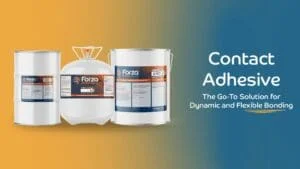What are rubber-based adhesives, and how do they work?
Rubber-based adhesives are adhesives that use rubber resin to make up the solids content, and contain tackifying resins as well as other specialty performance additives. Typically, they work by contact bonding, meaning you apply the adhesive to both surfaces and the adhesive is bonded to itself, taking along the surfaces they’re adhered to. Like our other contact & spray adhesives, they are usually sprayed, brushed or rolled on.
There are 2 main types of rubber-based adhesives – natural, or synthetic. Synthetic rubber-based adhesives are more versatile and stable than natural rubber-based adhesives, but are more expensive. Either one is a good option, it just depends on the application!
Rubber-based adhesives are really good for interior bonding and assembly applications, and are used for most anything – from laminate, to foam, and even furniture. They’re used for the bonding of organic and porous materials, such as leather, paper, fabrics and other rubber products. Rubber-based adhesives are used to make a variety of tapes, including double-coated film tapes, transfer tapes, foam tapes, duct tape and even carton sealing tapes. They’re often used in the hook and loop fastening system, and in sealing applications such as fabricating foam gaskets and seals.
Now that we’ve covered what they are and how they work, what are the pros and cons of using rubber-based adhesives?
| Pros | Cons |
| Very flexible | Lower temperatures can reduce initial tack |
| High initial tack | Higher temperatures can cause plasticizer migration |
| Cost-effective | Moderate shear resistance at elevated temperatures |
| Excellent peel adhesion to non-polar and polar surfaces | Low aging stability |
| Can be formulated to be removable, repositionable, or extremely permanent | Low UV and humidity resistance |
| Adheres to many surfaces including LSE plastics | Poor cohesion at higher temperatures (T>70C) |
| Usually less expensive and have a higher initial tack than acrylic-based adhesives | Low chemical, solvent and plasticizer resistance |
| Ideal for indoor applications | No residue-free removability after application |
| Provides an excellent amount of light-duty staying power | More susceptible to moisture and high temperatures, which may cause it to break down over time |
Curious to learn more about rubber-based adhesives, or how you can use them in your application? Contact us – we would love to chat adhesives with you!




